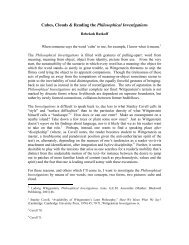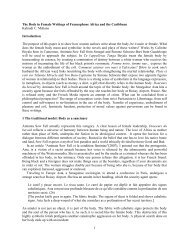Receptors and transduction in taste
Receptors and transduction in taste
Receptors and transduction in taste
Create successful ePaper yourself
Turn your PDF publications into a flip-book with our unique Google optimized e-Paper software.
<strong>in</strong>sight review articles<br />
activated by only one out of five compounds tested. Thus, the tun<strong>in</strong>g of<br />
receptor cells with respect to bitter compounds seems to be more<br />
focused than anticipated, <strong>and</strong> different bitter stimuli may activate,<br />
through the GPCRs expressed, different subpopulations of bittersensitive<br />
<strong>taste</strong> cells 22 . In agreement with this f<strong>in</strong>d<strong>in</strong>g, s<strong>in</strong>gle <strong>taste</strong> nerve<br />
fibres carry signals that discrim<strong>in</strong>ate between bitter compounds 50 .<br />
It is not only GPCRs that act as bitter receptors. Some bitter peptides<br />
with amphophilic properties <strong>in</strong>teract directly with G prote<strong>in</strong>s,<br />
probably by virtue of a structural similarity to the G-prote<strong>in</strong>-b<strong>in</strong>d<strong>in</strong>g<br />
site of the receptor 46 . Qu<strong>in</strong><strong>in</strong>e, also an amphophilic compound,<br />
permeates the cell membrane <strong>and</strong> activates G prote<strong>in</strong>s, bypass<strong>in</strong>g the<br />
receptor 51 . In Necturus, qu<strong>in</strong><strong>in</strong>e blocks apical K + channels 52 , whereas<br />
<strong>in</strong> the bullfrog, it activates a cation conductance <strong>in</strong> <strong>taste</strong> cells 53 .<br />
Denatonium blocks voltage-gated delayed-rectifier K + channels 54 .<br />
Caffe<strong>in</strong>e <strong>and</strong> other methyl-xanth<strong>in</strong>es also act without activat<strong>in</strong>g a<br />
GPCR (Fig. 3). After permeat<strong>in</strong>g the cell membrane they block an<br />
<strong>in</strong>tracellular phosphodiesterase <strong>and</strong> cause activation of a soluble<br />
guanylate cyclase 55 . The latter effect may be under control of nitric oxide,<br />
as nitric oxide synthase was found <strong>in</strong> <strong>taste</strong> cells 56 . As the result of these<br />
complex events, a transient <strong>in</strong>crease <strong>in</strong> guanid<strong>in</strong>e 3,5-cyclic<br />
monophosphate (cGMP) was measured with stopped-flow methods 55 .<br />
Bitter-<strong>taste</strong> <strong>transduction</strong><br />
Members of the T2R family were found co-expressed with the -subunit<br />
of the G prote<strong>in</strong> gustduc<strong>in</strong> 47 , a <strong>taste</strong>-specific signall<strong>in</strong>g prote<strong>in</strong><br />
long known to have a prom<strong>in</strong>ent role <strong>in</strong> bitter <strong>taste</strong> 6 . Knockout mice<br />
lack<strong>in</strong>g -gustduc<strong>in</strong> show decreased sensitivity for bitter agents such as<br />
denatonium <strong>and</strong> qu<strong>in</strong><strong>in</strong>e, <strong>and</strong> also for sweet agents such as sacchar<strong>in</strong><br />
<strong>and</strong> sucrose 57 . -Gustduc<strong>in</strong> activates a <strong>taste</strong>-specific phosphodiesterase<br />
58 , lower<strong>in</strong>g the cellular concentration of cyclic nucleotides 59 .<br />
Another <strong>transduction</strong> cascade is also activated simultaneously by<br />
the GPCR-mediated bitter signal (Fig. 3). Of the - <strong>and</strong> -subunits of<br />
heterotrimeric gustduc<strong>in</strong> 60 , G13 <strong>and</strong> G3 are able to activate<br />
phospholipase C2 (PLC2; refs 60–62), lead<strong>in</strong>g to the generation of<br />
<strong>in</strong>ositol-1,4,5-trisphosphate (Ins(1,4,5)P 3) 63,64 . This messenger activates<br />
Ins(1,4,5)P 3 receptors of <strong>in</strong>tracellular Ca 2+ stores, of which the<br />
type III receptor, which may be modulated by calcium ions <strong>and</strong> by<br />
cAMP-dependent k<strong>in</strong>ases, is the dom<strong>in</strong>ant form 65 . The receptor is<br />
co-expressed with PLC2 (ref. 66). Concomitantly, Ca 2+ ions are<br />
released <strong>in</strong>to the cytosol 20,21,67 . The subsequent elements of <strong>transduction</strong>,<br />
that is, the channels responsible for a change <strong>in</strong> membrane<br />
potential, rema<strong>in</strong> to be identified.<br />
Thus, the GPCR-mediated bitter signal triggers a transient<br />
decrease <strong>in</strong> cAMP <strong>and</strong> cGMP, accompanied by a transient <strong>in</strong>crease <strong>in</strong><br />
Ins(1,4,5)P 3 (refs 59, 64). Whether the two pathways, which are<br />
activated simultaneously, are connected, with the decrease <strong>in</strong> cyclic<br />
nucleotides enabl<strong>in</strong>g the <strong>in</strong>crease <strong>in</strong> Ins(1,4,5)P 3, has not yet been<br />
determ<strong>in</strong>ed. Furthermore, it is unclear why dual signall<strong>in</strong>g should<br />
be required for bitter <strong>taste</strong>, <strong>and</strong> whether or not it is more than<br />
parallel amplification. A similar design is not found <strong>in</strong> the receptor<br />
cells of other senses, <strong>and</strong> the other major chemoreceptive organ —<br />
the nose — seems to do well without it (see review <strong>in</strong> this issue by<br />
Fireste<strong>in</strong>, pages 211–218).<br />
Sweet <strong>taste</strong><br />
Sweet <strong>taste</strong> responds to soluble carbohydrates present <strong>in</strong> sufficient<br />
concentrations <strong>in</strong> the oral cavity, guid<strong>in</strong>g high-calorie <strong>in</strong>take. Yet a<br />
wide diversity of non-carbohydrate molecules is also sweet. Sweet<br />
<strong>taste</strong> has a strong hedonic (pleasant) effect 1 .<br />
Considerable efforts have been made by chemists <strong>and</strong> researchers<br />
<strong>in</strong> food-produc<strong>in</strong>g companies to deduce from hundreds of sweettast<strong>in</strong>g<br />
compounds common structural features that were expected<br />
to capture characteristics of ‘the’ sweet molecule <strong>and</strong>, therefore, ‘the’<br />
sweet receptor. The b<strong>in</strong>d<strong>in</strong>g-site models obta<strong>in</strong>ed seemed realistic <strong>in</strong><br />
that they could be used to design new high-potency sweeteners 68 . The<br />
time has come, however, to def<strong>in</strong>e sweet receptors more directly<br />
us<strong>in</strong>g the tools of genetics <strong>and</strong> molecular biology.<br />
A first success was achieved by clon<strong>in</strong>g a c<strong>and</strong>idate trehalose<br />
receptor of Drosophila 69 . It is a GPCR that has only a short NTD<br />
(Fig. 2). In the mouse genome, sweet-receptor genes are most likely<br />
located on chromosome 4, where two sweet <strong>taste</strong>-related locations<br />
are found, the Dpa locus <strong>and</strong> the Sac locus 70,71 . Mutations <strong>in</strong> the Dpa<br />
locus resulted <strong>in</strong> a partial loss of <strong>taste</strong> acuity for the sweet am<strong>in</strong>o acid<br />
D-phenylalan<strong>in</strong>e, whereas mutations <strong>in</strong> the Sac locus caused a partial<br />
loss of <strong>taste</strong> acuity for sucrose, sacchar<strong>in</strong> <strong>and</strong> other sweeteners.<br />
Search<strong>in</strong>g the new genomic databases near these two loci may<br />
uncover genes for sweet receptors.<br />
When applied recently to the Sac locus, this strategy proved<br />
remarkably successful. The receptor T1R3, found simultaneously by<br />
four laboratories 72–75 , has a large NTD (Fig. 2), just like the orphan<br />
receptors T1R1 <strong>and</strong> T1R2 described previously 76 . T1R3 was found <strong>in</strong><br />
buds of the anterior, lateral <strong>and</strong> posterior tongue. It is expressed <strong>in</strong><br />
many <strong>taste</strong> cells which also express the orphan T1R2, suggest<strong>in</strong>g that<br />
the two receptors serve a common function. They might, for<br />
<strong>in</strong>stance, form heterodimers, as is known from some other GPCRs<br />
with large NTDs 72,73 .<br />
As the gene Tas1r3 is the only GPCR-cod<strong>in</strong>g gene at the Sac locus,<br />
its product T1R3 is a strong c<strong>and</strong>idate for a sweet receptor. This conjecture<br />
is supported by additional observations. First, stra<strong>in</strong>s of mice<br />
that differ <strong>in</strong> sweet-<strong>taste</strong> ability also differ by several po<strong>in</strong>t mutations<br />
<strong>in</strong> Tas1r3. These changes do not affect expression, but may result <strong>in</strong> a<br />
decl<strong>in</strong>e of function. Of course, ow<strong>in</strong>g to extended polymorphism, the<br />
stra<strong>in</strong>s also differ by many more mutations outside of Tas1r3. Second,<br />
<strong>in</strong>breed<strong>in</strong>g of <strong>taste</strong>r <strong>and</strong> non-<strong>taste</strong>r stra<strong>in</strong>s revealed a correlation<br />
between alleles received <strong>and</strong> sweet-<strong>taste</strong> acuity 73 . In the future, a more<br />
detailed proof might show that transgenic non-<strong>taste</strong>r mice become<br />
<strong>taste</strong>rs when Tas1r3 is switched on. The <strong>in</strong>k was not yet dry on the<br />
c<strong>and</strong>idate sweet receptor T1R3, when Charles Zuker <strong>and</strong> co-workers<br />
managed to express this GPCR <strong>in</strong> oocytes. They found that the receptor<br />
does not respond to sweeteners on its own. But responses were<br />
obta<strong>in</strong>ed after co-express<strong>in</strong>g T1R3 together with T1R2, show<strong>in</strong>g that<br />
the first functional sweet receptor found <strong>in</strong> mammals is a dimer 77 .<br />
Sweet-<strong>taste</strong> <strong>transduction</strong><br />
How is T1R3 coupled to the <strong>transduction</strong> mach<strong>in</strong>ery? This GPCR is<br />
expressed by about 20% of the <strong>taste</strong> cells, some of which also express<br />
-gustduc<strong>in</strong>. The precise extent of co-expression is debatable, however,<br />
as one group found that less than 20% of the T1R3 cells have a<br />
222 NATURE | VOL 413 | 13 SEPTEMBER 2001 | www.nature.com<br />
© 2001 Macmillan Magaz<strong>in</strong>es Ltd<br />
NOS<br />
NO<br />
Caffe<strong>in</strong>e<br />
Theophyll<strong>in</strong>e<br />
PDE PDE<br />
cGMP,<br />
transient<br />
<strong>in</strong>crease<br />
sGC<br />
R<br />
Cont<strong>in</strong>uous<br />
source?<br />
Cycloheximide<br />
Nicot<strong>in</strong>e, Strichn<strong>in</strong>e<br />
Qu<strong>in</strong><strong>in</strong>e, Denatonium<br />
Others<br />
α<br />
cAMP, cGMP<br />
transient<br />
decrease<br />
βγ<br />
PLC<br />
β2<br />
IP3<br />
transient<br />
<strong>in</strong>crease<br />
Ca 2+<br />
DAG<br />
Figure 3 Transduction of bitter <strong>taste</strong> as elicited by a variety of lig<strong>and</strong>s. Rs, multiple<br />
GPCRs of the T2R family, coupled to the G prote<strong>in</strong> gustduc<strong>in</strong> 47–49 ; , -subunit of<br />
gustduc<strong>in</strong> 6,57 ; , G-prote<strong>in</strong> subunits 3 <strong>and</strong> 13 (refs 60–62); PLC2,<br />
phospholipase C subtype 61 ; Ins(1,4,5)P 3, <strong>in</strong>ositol-1,4,5-trisphosphate 59 ; PDE, <strong>taste</strong>specific<br />
phosphodiesterase 58 ; cAMP, cyclic adenos<strong>in</strong>e monophosphate 59 ; cGMP,<br />
cyclic guanos<strong>in</strong>e monophosphate 59 ; sGC, soluble guanylate cyclase 55 ; NO, nitric<br />
oxide 55 ; NOS, NO synthase 56 . For second-messenger k<strong>in</strong>etics, see refs 55,59,63,64.
















